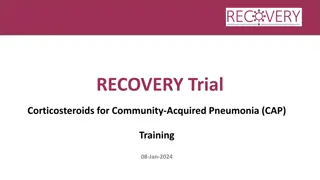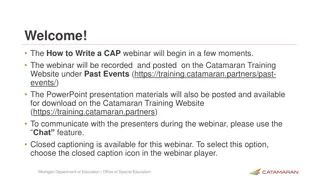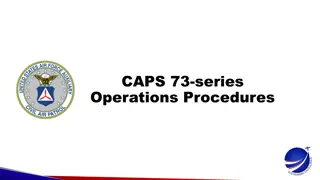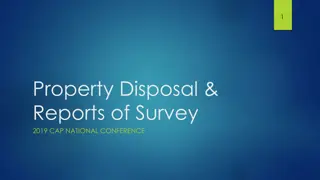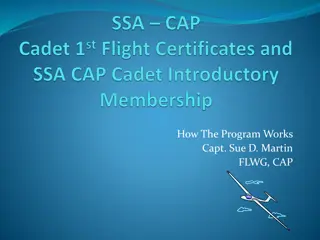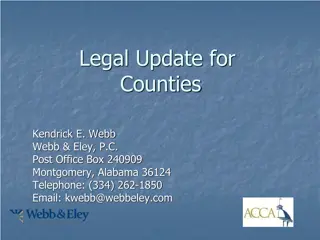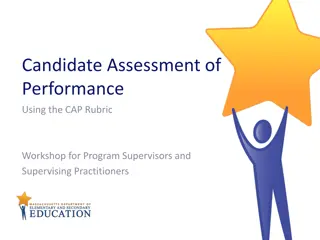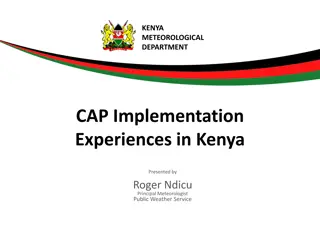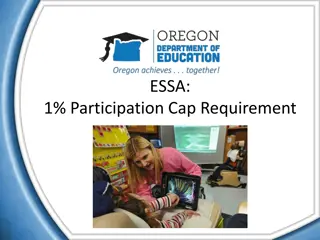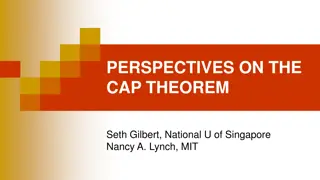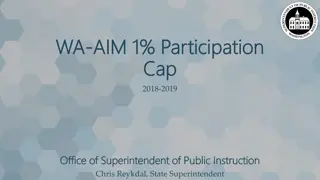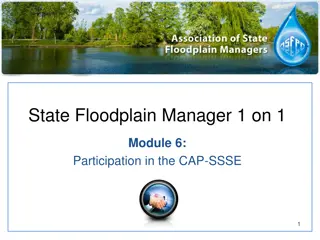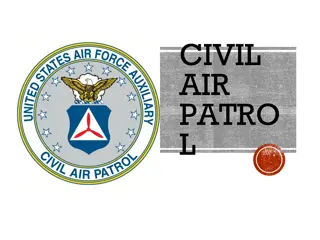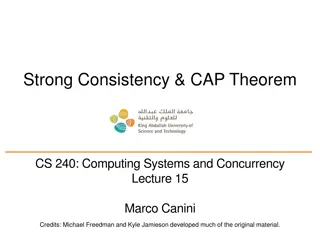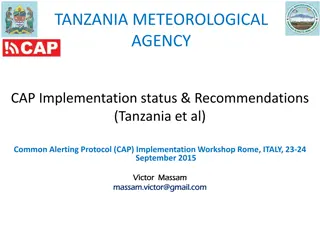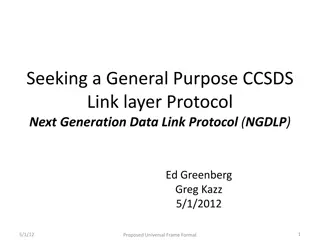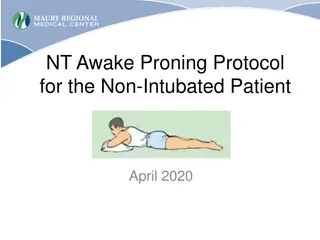Adaptive Tree-based Convergecast Protocol
Adaptive tree-based protocol for managing overlay networks in heterogeneous networks. It proposes improvements to the existing Tree-Based Convergecast Routing (TBCR) protocol by considering additional parameters such as RTT, power consumption, link stability, and link mobility to optimize routing de
32 views • 12 slides
Computer/Electronic Accommodations Program (CAP) Overview and Impact on Accessibility
Providing insights into the Computer/Electronic Accommodations Program (CAP) established by the Department of Defense to support employees with disabilities and Service members, this presentation covers the program's background, services, and outreach activities. Learn how CAP equips individuals wit
0 views • 37 slides
US Reaches Its H-1B Visa Cap for 2023
The United States government has reached its congressionally mandated H-1B visa cap for the fiscal year 2023 \u2013 meaning employers will have to wait until April 1, 2024, to start filing applications. The US Citizenship and Immigration Services (USCIS) announced that it had received enough petitio
0 views • 2 slides
RECOVERY Trial: Corticosteroids for Community-Acquired Pneumonia (CAP) - Overview and Eligibility Criteria
Community-Acquired Pneumonia (CAP) is a common reason for hospitalization globally, with estimated annual fatalities of approximately 2.5 million. The RECOVERY Trial is investigating the use of corticosteroids in patients with CAP suspected or confirmed to be of bacterial origin. Eligibility criteri
1 views • 13 slides
How to Write a CAP Webinar Overview
The How to Write a Corrective Action Plan (CAP) webinar provides insights on different types of CAPs, the CAP workflow, and the role of districts and ISDs in implementing corrective actions. The presentation also covers the overview of CAP differences and data CAPs, emphasizing the importance of acc
0 views • 41 slides
I-Cap Marine Ltd - Yacht Management Services Overview
I-Cap Marine Ltd, a part of the I-Cap Group, offers yacht management services with a focus on client-centric relationships, quality service, and a proactive approach. Their dedicated team provides expert advice and administration services for superyacht ownership, registration, crew management, and
0 views • 6 slides
Understanding OSI Model and TCP/IP Protocol Suite
Explore the concept of layering in data communication, comparing the OSI model and TCP/IP protocol suite. Learn about protocol layers, protocol hierarchies, and the functionality of each layer in these models. Discover the interrelationships between layers and the evolution from OSI to TCP/IP.
5 views • 57 slides
Coordinated AP Time/Frequency Sharing in IEEE 802.11be
The document discusses Coordinated AP (CAP) Time/Frequency Sharing in Transmit Opportunity in IEEE 802.11be, focusing on Frequency and Time resource sharing between multiple APs in close proximity. It introduces concepts like CAP OFDMA and CAP TDMA, outlining the benefits in terms of latency improve
0 views • 15 slides
London Homeless Coalition (LHC) Death Communication Protocol
In 2014, the Memorial Committee of the London Homeless Coalition (LHC) established the Death Communication Protocol to acknowledge, share, and address the loss of individuals experiencing homelessness. The protocol aims to inform partnering organizations of confirmed or unconfirmed deaths, support g
0 views • 12 slides
Understanding Mobile Computing and TCP/IP Protocol Suite
Mobile computing is crucial for continuous internet connectivity regardless of physical location. The TCP/IP protocol suite, consisting of Transmission Control Protocol (TCP) and Internet Protocol (IP), forms the backbone of internet infrastructure. IP addressing and mobility challenges are addresse
2 views • 51 slides
Civil Air Patrol Operations Procedures and Philosophy
Explore the comprehensive operations procedures and philosophy of the Civil Air Patrol (CAP), emphasizing the importance of professionalism, teamwork, and adherence to standards. Learn about the core procedures, mission planning, briefing, risk assessment, and the ultimate responsibility of the pilo
0 views • 8 slides
Understanding OSI Model and TCP/IP Protocol Suite in Computer Networking
This chapter explores the OSI model and TCP/IP protocol suite, delving into protocol layers, addressing mechanisms, and network components. It highlights the interface between layers, functions of each layer in the OSI model, and compares TCP/IP protocol suite layers with OSI model layers. The discu
0 views • 30 slides
Coordinated AP Time/Frequency Sharing in IEEE 802.11be
The document discusses the concept of Coordinated AP (CAP) Time/Frequency Sharing within a Transmit Opportunity (TXOP) in the IEEE 802.11be standard. It explains the procedures of Frequency and Time resource sharing, highlighting the benefits such as latency improvement and throughput fairness. Deta
1 views • 16 slides
Property Disposal & Reports of Survey Guidelines at 2019 CAP National Conference
Guidelines for proper disposal of property and conducting reports of survey at the 2019 CAP National Conference. Discusses disposing property, capitalization of fixed assets, and the process of conducting reports of survey in the CAP organization.
0 views • 14 slides
MAAP Protocol Overview in IEEE 1722: Address Acquisition and Message Format
The MAAP (Multicast Address Acquisition Protocol) is defined in IEEE 1722 for time-sensitive applications in bridged local area networks. It involves acquiring multicast addresses through claiming, probing, and defending messages. MAAP enables dynamic allocation of addresses and defending against co
1 views • 8 slides
SSA-CAP Partnership: Cadet Glider Flight Program Guidelines
The SSA-CAP partnership offers cadets a unique opportunity for glider flight experiences through a renewable MOA. CAP senior members play a key role in presenting certificates to cadets, enabling them to become SSA CAP Cadet Introductory Members. The enrollment process, benefits, and steps involved
0 views • 8 slides
IEEE 802.11-20/1761r1 Ranging Protocol for 11bd
This document outlines the ranging protocol proposed for IEEE 802.11-20/1761r1, focusing on RTT-based ranging leveraging multi-channel operation. By integrating the 11az ranging protocol, it enables flexible and low-overhead application in 11bd for improved accuracy in ITS bands. The protocol includ
1 views • 13 slides
Understanding EIGRP: A Comprehensive Overview
Enhanced Interior Gateway Routing Protocol (EIGRP) is a dynamic routing protocol providing various advantages to network administrators. It is a classless routing protocol supporting VLSM and is considered an Interior Gateway Protocol (IGP). EIGRP uses advanced distance vector routing and is known f
1 views • 5 slides
Understanding Soft Gamma-Ray Emissions from Pulsar Polar Caps
Soft gamma-ray emissions from the polar cap cascade region are a subject of interest in astrophysics, with studies focusing on the fundamental physical processes of pulsars and potential origins of non-thermal X-ray emissions. Researchers explore the emission processes, polar cap accelerators, casca
0 views • 16 slides
Legal Update on Statutory Cap for Cities and Counties in Alabama
Alabama's statutory cap on damages against cities and counties has been a topic of contention since its enactment in 1977. Attempts to circumvent this cap by suing city or county employees individually have led to legal debates and court decisions, such as the cases of Morrow v. Caldwell and Alabama
1 views • 36 slides
Proposals for a Sustainable Common Agricultural Policy (CAP) Reform
The future of the Common Agricultural Policy (CAP) in Europe faces challenges such as market volatility, price fluctuations, and societal expectations. To address these issues, four key proposals were put forth by the Academy of Agriculture of France in 2017: softening price volatility, implementing
0 views • 8 slides
Candidate Assessment of Performance Using the CAP Rubric: Workshop Overview
This workshop conducted for program supervisors and supervising practitioners focuses on utilizing the CAP Rubric to assess candidate performance. The agenda includes warming up, learning about the CAP Rubric, understanding its goals and purposes, and detailing the CAP process. Participants engage i
0 views • 39 slides
Implementation Experiences of CAP by Kenya Meteorological Department
Kenya Meteorological Department (KMD) has been implementing the Common Alerting Protocol (CAP) since late 2012 to enhance the production and dissemination of weather advisories and warnings. KMD is responsible for generating weather alerts, identifying threat events, and classifying messages based o
0 views • 24 slides
Understanding ESSA 1% Participation Cap Requirement
ESSA reauthorized the requirements for the alternate assessment based on alternate academic achievement standards, setting a 1% participation cap on each content area for students with significant cognitive disabilities. States must publicly share district data, and districts exceeding the cap must
0 views • 16 slides
Overview of the Common Agricultural Policy (CAP) in Europe
The Common Agricultural Policy (CAP) in Europe emerged after World War II to address food shortages. It aims to increase agricultural productivity, support farmers' livelihoods, stabilize markets, ensure food security, and maintain reasonable prices for consumers. CAP is guided by principles of a si
0 views • 21 slides
CAP Implementation Progress in Mali-Meteo and Fast-Tracking in Africa
The Common Alerting Protocol (CAP) implementation in Mali-Meteo by Ismahila Koumare has been significant, with successful alert issuance since 2021. Collaboration with WMO and efforts to fast-track CAP implementation in five African countries show progress and challenges. Mali-Meteo has used cloud-b
0 views • 9 slides
Understanding Salary Cap and Cost Sharing in Research Grants
Salary cap in research grants is the maximum allowable difference between what is charged and the cap set by NIH. This ensures cost-sharing responsibilities are met appropriately. Key points include FY vs. AY salary, different levels of salary caps for fiscal years, and the establishment of new awar
0 views • 21 slides
Understanding the CAP Theorem in Distributed Systems
The CAP Theorem, as discussed by Seth Gilbert and Nancy A. Lynch, highlights the tradeoffs between Consistency, Availability, and Partition Tolerance in distributed systems. It explains how a distributed service cannot provide all three aspects simultaneously, leading to practical compromises and re
0 views • 28 slides
CAP Studios: Peer Writing Assistance Program
CAP Studios, presented by Shelby Karch, provides personalized assistance to students with their writing assignments. Peer tutors support students at all writing stages, offering feedback, guidance, and resources. The program emphasizes student collaboration, critical thinking, and independent develo
0 views • 8 slides
CAP Implementation in Cuba: Experiences and Perspectives for Rapid Progress
José Rubiera, Ph.D., discusses the urgent need for implementing the Common Alerting Protocol (CAP) in Cuba to enhance weather watches and warnings. The challenges faced by the Cuban Meteorological Service are explored, along with plans for CAP implementation in 2020. The overview of Cuba's weather
0 views • 37 slides
Prediction of Liver Fibrosis in NAFLD Patients: Impact of CAP Values
Steatosis has emerged as a significant diagnosis with NAFLD becoming a common cause for hepatologic evaluation. Liver stiffness measurement (LSM) using transient elastography is vital for assessing fibrosis severity in NAFLD patients. However, the accuracy of LSM can be influenced by obesity and sev
0 views • 35 slides
Understanding the 1% Participation Cap in Education
Explanation of the 1% Participation Cap in education, focusing on identifying the right students for the WA-AIM assessment. Discusses ESEA requirements, district justifications, and the assessment criteria for students with significant cognitive disabilities. Emphasizes the need for oversight and pu
0 views • 16 slides
Cap Calculation and Salary Allocation in Workday
Workday's salary cap calculations and allocations for clinical components like Y salary can impact grant budgeting. The system may not fully recognize clinical components within the Institutional Base Salary (IBS), affecting cap sufficiency. Effort commitment allocations can help correct direct char
0 views • 11 slides
State Floodplain Manager 1-on-1 Module 6: CAP-SSSE Participation
This module focuses on developing participants' understanding and skills to be valuable partners to FEMA through the CAP-SSSE program. It covers topics such as leveraging federal programs, building relationships, and obtaining FEMA resources to achieve state floodplain management goals. Through lect
0 views • 96 slides
Explore Civil Air Patrol: Serving the Community Through Aviation Education
Civil Air Patrol (CAP) is a humanitarian organization and official auxiliary of the US Air Force. Its three main missions include emergency services, cadet programs, and aerospace education. CAP offers aerospace education for teachers and students, providing access to various resources and programs
0 views • 36 slides
Understanding Strong Consistency & CAP Theorem in Computing Systems
Explore the concepts of strong consistency, CAP theorem, network partitions, linearizability, and how systems handle partitions. Delve into the trade-offs between consistency, availability, and partition-tolerance as outlined by the CAP theorem.
0 views • 42 slides
Implementation Status and Recommendations for CAP in Tanzania Meteorological Agency
Tanzania Meteorological Agency has successfully implemented the Common Alerting Protocol (CAP) under the Meteorology category, enabling timely dissemination of information to the public through various media channels. Recommendations include protocol adoption, system availability, promotion through
0 views • 20 slides
Understanding Protocol Deviations in Clinical Trials
Protocol deviations are expected occurrences in clinical trials that may arise from site or participant actions. It is crucial for research teams to identify, report, and learn from these deviations to ensure the integrity and safety of the study. Mechanisms for identifying and reporting deviations,
0 views • 16 slides
Seeking a General-Purpose CCSDS Link Layer Protocol: Next-Generation Data Link Protocol (NGDLP)
This document discusses the proposed Universal Frame Format for a next-generation data link protocol, focusing on major questions about transfer frames, Protocol Link Transmission Unit (PLTU), and Universal Transfer Frame Structure. It explores topics such as frame formats, telemetry transfer frames
0 views • 24 slides
NT Awake Proning Protocol for Non-Intubated Patients
This protocol outlines the benefits and procedure for prone positioning in non-intubated patients experiencing mild to moderate hypoxemia. It highlights patient eligibility criteria, equipment required, and considerations for nursing care. The protocol emphasizes improving oxygenation by promoting a
0 views • 11 slides



